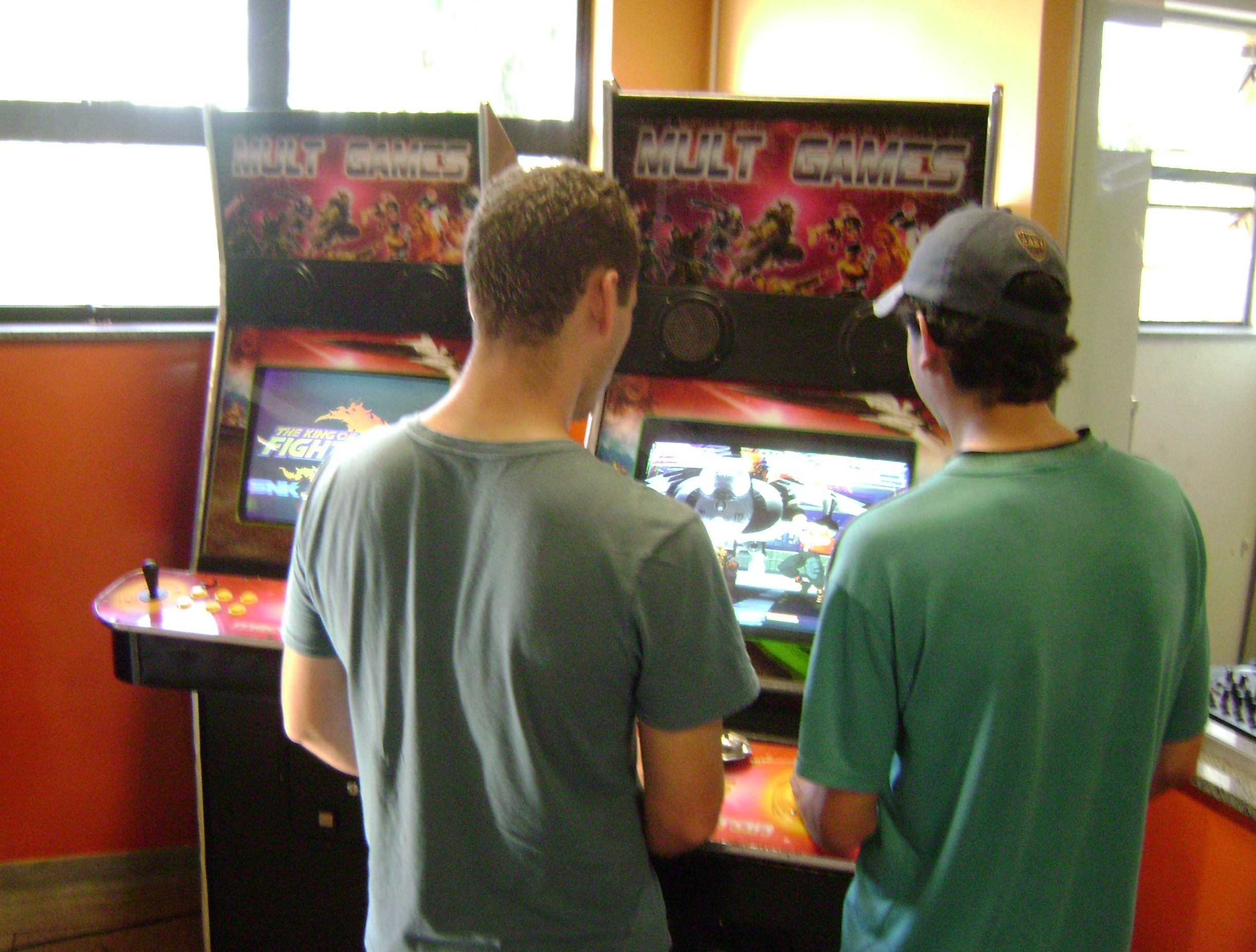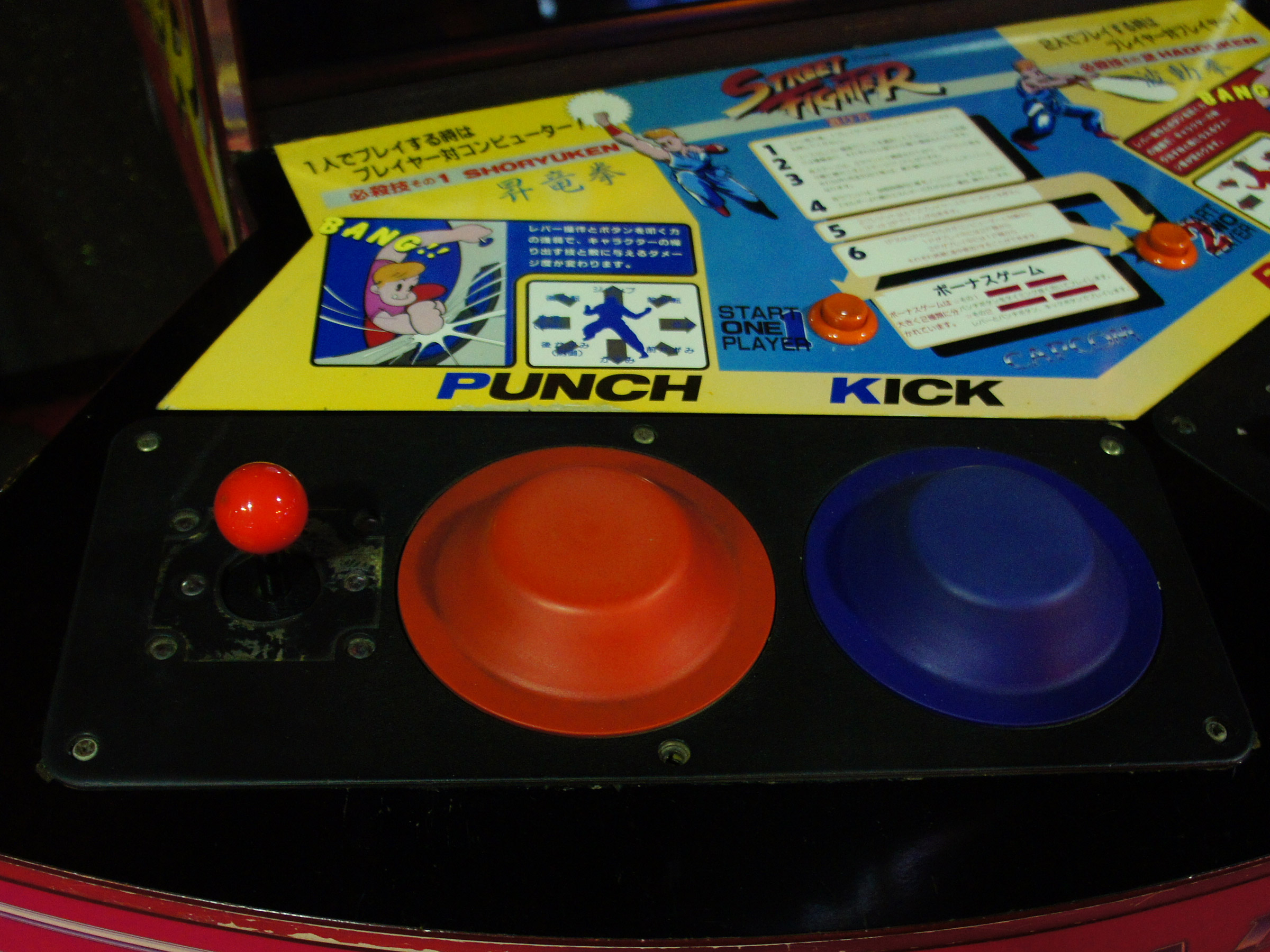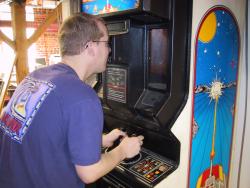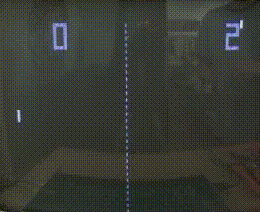|
Arcade Cabinet
An arcade cabinet, also known as an arcade machine or a coin-op cabinet or coin-op machine, is the housing within which an arcade game's electronic hardware resides. Most cabinets designed since the mid-1980s conform to the Japanese Amusement Machine Manufacturers Association (JAMMA) wiring standard. Some include additional connectors for features not included in the standard. Parts of an arcade cabinet Because arcade cabinets vary according to the games they were built for or contain, they may not possess all of the parts listed below: *A display output, on which the game is displayed. They may display either raster or vector graphics, raster being most common. Standard resolution is between 262.5 and 315 vertical lines, depending on the refresh rate (usually between 50 and 60 Hz). Slower refresh rates allow for better vertical resolution. Monitors may be oriented horizontally or vertically, depending on the game. Some games use more than one monitor. Some newer cabinets h ... [...More Info...] [...Related Items...] OR: [Wikipedia] [Google] [Baidu] |
One-way Mirror
A one-way mirror, also called two-way mirror (or one-way glass, half-silvered mirror, and semi-transparent mirror), is a reciprocal mirror that appears reflective on one side and transparent at the other. The perception of one-way transmission is achieved when one side of the mirror is brightly lit and the other side is dark. This allows viewing from the darkened side but not vice versa. History The first US patent for a one-way mirror appeared in 1903, then named a "transparent mirror". Principle of operation The glass is coated with, or has been encased within, a thin and almost-transparent layer of metal (window film usually containing aluminium). The result is a mirrored surface that reflects some light and is penetrated by the rest. Light always passes equally in both directions. However, when one side is brightly lit and the other kept dark, the darker side becomes difficult to see from the brightly lit side because it is masked by the much brighter reflection of the ... [...More Info...] [...Related Items...] OR: [Wikipedia] [Google] [Baidu] |
Street Fighter (video Game)
is a 1987 arcade game developed by Capcom. It is the first competitive fighting game produced by the company and the first installment in the ''Street Fighter'' series. It was a commercial success in arcades and introduced special attacks and some of the conventions made standard in later fighting games, such as the six-button controls and the use of command-based special moves. ''Street Fighter'' was directed by Takashi Nishiyama, who conceived it by adapting the boss battles of his earlier beat 'em up game '' Kung-Fu Master'' (1984) for a one-on-one fighting game, and by drawing influence from popular Japanese shōnen manga. A port for the PC Engine/TurboGrafx CD console was released as in 1988, and was re-released for the Wii's Virtual Console in 2009. Its sequel, '' Street Fighter II'' (1991), evolved its gameplay with phenomenal worldwide success. ''Street Fighter'' also spawned two spiritual successors, Capcom's beat 'em up ''Final Fight'' (working title ''Street Fi ... [...More Info...] [...Related Items...] OR: [Wikipedia] [Google] [Baidu] |
Battlezone (1980 Video Game)
''Battlezone'' is a first-person shooter tank combat game released for arcades in November 1980 by Atari, Inc. The player controls a tank which is attacked by other tanks and missiles, using a small radar scanner to locate enemies around them in the barren landscape. Its innovative use of 3D graphics made it a huge hit, with approximately 15,000 units sold. With its use of three-dimensional vector graphics, the game is considered to be the first true 3D arcade game with a first-person perspective, the "first big 3D success" in the video game industry, and the first successful first-person shooter video game in particular, making it a milestone for first-person shooter games. The game was primarily designed by Ed Rotberg, who was mainly inspired by Atari's top-down shooter game ''Tank'' (1974). ''Battlezone'' was distributed in Japan by Sega and Taito in 1981. The system was based on vector hardware designed by Howard Delman which was introduced in '' Lunar Lander'' and saw suc ... [...More Info...] [...Related Items...] OR: [Wikipedia] [Google] [Baidu] |
Smash TV
''Smash TV'' is a 1990 arcade video game created by Eugene Jarvis and Mark Turmell for Williams Electronics Games. It is a dual-stick shooter (one for moving and the other for firing) in the same vein as 1982's '' Robotron: 2084'' (co-created by Jarvis). The Super NES, Genesis, Master System, and Game Gear versions are titled ''Super Smash TV''. The plot centers on a dystopian television show during the then-future year of 1999, where one or two contestants must shoot their way to fame and fortune; the show is taped in front of a live studio audience with broadcast via satellite worldwide. The goal of the game show is to kill or be killed, and once all of the challengers in each arena have been massacred, the contestant(s) will proceed to survive the next gauntlet. Gameplay 250px, left, Arcade screenshot The play mechanic is similar to that of Eugene Jarvis' earlier '' Robotron: 2084'', with dual-joystick controls and series of single-screen arenas. While most of the enemies i ... [...More Info...] [...Related Items...] OR: [Wikipedia] [Google] [Baidu] |
2084
2084 may refer to: * 2084 is a number in the 2000–2999 range Time * 2084 CE (year), MMLXXXIV, the year ''A.D. 2084'' * 2084 BC (year), the year ''2084 BCE'' Places * 2084 Okayama, Asteroid #2084, also called ''Okayama'' * Farm to Market Road 2084, Texas Road ''2084'', in the U.S.A. People * Tom Tom MMLXXXIV (musician), a music arranger who worked on the 2002 Liam Hayes album ''Fed'' (album) Entertainment works/titles * '' Robotron: 2084'', a 1982 video game in the Robotron series of videogames * '' 2084: The End of the World'', a 2015 French-language novel by Boualem Sansal * ''2084'' (film), a 1984 science fiction film * ''2084'', a comics work by Goran Parlov Other uses * SMPTE ST 2084, standard #2084 from SMTPE, also called ''Perceptual Quantizer'' (PQ) * United Nations Security Council Resolution 2084, resolution #2084 passed by the U.N. Security Council * ''Partnership to Build America Act'' (H.R. 2084), a federal bill introduced by U.S. Representative John Delaney ... [...More Info...] [...Related Items...] OR: [Wikipedia] [Google] [Baidu] |
Pong
''Pong'' is a table tennis–themed twitch arcade sports video game, featuring simple two-dimensional graphics, manufactured by Atari and originally released in 1972. It was one of the earliest arcade video games; it was created by Allan Alcorn as a training exercise assigned to him by Atari co-founder Nolan Bushnell, but Bushnell and Atari co-founder Ted Dabney were surprised by the quality of Alcorn's work and decided to manufacture the game. Bushnell based the game's concept on an electronic ping-pong game included in the Magnavox Odyssey, the first home video game console. In response, Magnavox later sued Atari for patent infringement. ''Pong'' was the first commercially successful video game, and it helped to establish the video game industry along with the Magnavox Odyssey. Soon after its release, several companies began producing games that closely mimicked its gameplay. Eventually, Atari's competitors released new types of video games that deviated from ''Pong'''s origi ... [...More Info...] [...Related Items...] OR: [Wikipedia] [Google] [Baidu] |
Arkanoid
is a 1986 block breaker arcade game developed and published by Taito. In North America, it was published by Romstar. Controlling a paddle-like craft known as the Vaus, the player is tasked with clearing a formation of colorful blocks by deflecting a ball towards it without letting the ball leave the bottom edge of the playfield. Some blocks contain power-ups that have various effects, such as increasing the length of the Vaus, creating several additional balls, or turning the Vaus into a laser cannon. Other blocks may be indestructible or require multiple hits to break. Created by Taito designers Akira Fujita and Hiroshi Tsujino, ''Arkanoid'' expanded on the concept established in Atari's '' Breakout'', a successful game in its own right that was met with a large wave of similar clone games from other manufacturers. It was part of a contest within Taito, where two teams of designers had to complete a block breaker game and determine which one was superior to the other. The film ... [...More Info...] [...Related Items...] OR: [Wikipedia] [Google] [Baidu] |
Trackball
A trackball is a pointing device consisting of a ball held by a socket containing sensors to detect a rotation of the ball about two axes—like an upside-down ball mouse with an exposed protruding ball. Users roll the ball to position the on-screen pointer, using their thumb, fingers, or the palm of the hand, while using the fingertips to press the buttons. With most trackballs, operators have to lift their finger, thumb or hand and reposition in on the ball to continue rolling, whereas a mouse would have to be lifted itself and re-positioned. Some trackballs have notably low friction, as well as being made of a dense material such as phenolic resin, so they can be spun to make them coast. The trackball's buttons may be in similar positions to those of a mouse, or configured to suit the user. Large trackballs are common on CAD workstations for easy precision. Before the advent of the touchpad, small trackballs were common on portable computers (such as the BlackBerry Tour) wh ... [...More Info...] [...Related Items...] OR: [Wikipedia] [Google] [Baidu] |
Gamepad
A gamepad is a type of video game controller held in two hands, where the fingers (especially thumbs) are used to provide input. They are typically the main input device for video game consoles. Features Gamepads generally feature a set of buttons handled with the right thumb and a direction controller handled with the left. The direction controller has traditionally been a four-way digital cross (also named a joypad, or alternatively a D-pad, and never called arrow keys), but most modern controllers additionally (or as a substitute) feature one or more analog sticks. Some common additions to the standard pad include shoulder buttons (also called "bumpers") and triggers placed along the edges of the pad (shoulder buttons are usually digital, i.e. merely on/off; while triggers are usually analog); centrally placed ''start'', ''select'', and ''home'' buttons, and an internal motor to provide force feedback. Analog triggers, like that of the GameCube controller, are pressure ... [...More Info...] [...Related Items...] OR: [Wikipedia] [Google] [Baidu] |
Video Game Console
A video game console is an electronic device that Input/output, outputs a video signal or image to display a video game that can be played with a game controller. These may be home video game console, home consoles, which are generally placed in a permanent location connected to a television or other display devices and controlled with a separate game controller, or handheld game console, handheld consoles, which include their own display unit and controller functions built into the unit and which can be played anywhere. Hybrid consoles combine elements of both home and handheld consoles. Video game consoles are a specialized form of a home computer geared towards video game playing, designed with affordability and accessibility to the general public in mind, but lacking in raw computing power and customization. Simplicity is achieved in part through the use of game cartridges or other simplified methods of distribution, easing the effort of launching a game. However, this leads ... [...More Info...] [...Related Items...] OR: [Wikipedia] [Google] [Baidu] |
Push-button
A push-button (also spelled pushbutton) or simply button is a simple switch mechanism to control some aspect of a machine or a process. Buttons are typically made out of hard material, usually plastic or metal. The surface is usually flat or shaped to accommodate the human finger or hand, so as to be easily depressed or pushed. Buttons are most often biased switches, although many un-biased buttons (due to their physical nature) still require a spring to return to their un-pushed state. Terms for the "pushing" of a button include pressing, depressing, mashing, slapping, hitting, and punching. Uses The "push-button" has been utilized in calculators, push-button telephones, kitchen appliances, and various other mechanical and electronic devices, home and commercial. In industrial and commercial applications, push buttons can be connected together by a mechanical linkage so that the act of pushing one button causes the other button to be released. In this way, a stop button ... [...More Info...] [...Related Items...] OR: [Wikipedia] [Google] [Baidu] |






